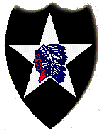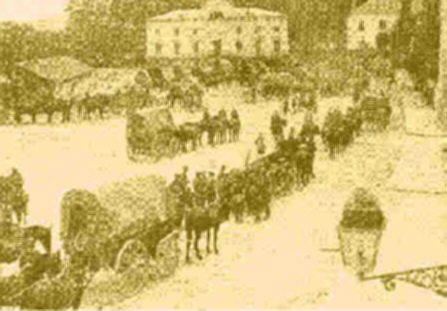|
|
Quick Facts | Description |
Quick Facts
-
 Where: The Aisne-Marne Sector, 3.5 miles immediately northwest of the town of Chateau-Thierry on the River Marne.
Where: The Aisne-Marne Sector, 3.5 miles immediately northwest of the town of Chateau-Thierry on the River Marne.
Check the Location on a Map of the Western Front
-
 When: July 1 - 10, 1918
When: July 1 - 10, 1918
-
 AEF Units Participating: Under command of the III Corps of the Sixth French Army - Second Division Key Commanders and Units: General Lewis, commanding the 3rd Brigade, Colonel Malone of the 23rd Infantry, Colonel Upton of the 9th Infantry and Colonel Bowley of the 17th Field Artillery.
AEF Units Participating: Under command of the III Corps of the Sixth French Army - Second Division Key Commanders and Units: General Lewis, commanding the 3rd Brigade, Colonel Malone of the 23rd Infantry, Colonel Upton of the 9th Infantry and Colonel Bowley of the 17th Field Artillery.
Click Here To See the disposition of 2nd Division forces around the Village of Vaux.
-
 Opposing Forces: From German Army Group Crown Prince - 402nd Infantry Regiment and other supporting units.
Opposing Forces: From German Army Group Crown Prince - 402nd Infantry Regiment and other supporting units.
 Memorable As: A perfectly executed tactical operation to close out 2nd Division operations around Chateau-Thierry.
Memorable As: A perfectly executed tactical operation to close out 2nd Division operations around Chateau-Thierry.

Village of Vaux
During their fighting for the Bois de Belleau, the front of the 3rd Brigade, with the exception of the movement by the 23rd Infantry on June 6th, had been comparatively quiet. However, the brigade had not been inactive. Trench construction was pushed vigorously, and aggressive patrols dominated the enemy's front. Artillery and machine gun fire raked the lines nightly, and by day took their toll on individuals or groups under observation. A notable incident was a German gas attack on the night of June 23-24 which caused over four hundred gas casualties.
The position of this brigade had never been satisfactory, forming as it did a deep [indentation]. This gave too long a line, required too many men to hold it, the field of view was poor and the defensive organization lacked depth. For these reasons the corps commander had directed the division commander to undertake operations at the proper time to straighten out this angle. On June 14th when General Dégoutte was turning over command of the corps to General Naulin, both generals called at division headquarters to consult as to this operation. The idea was a series of partial operations, each well supported by artillery, which should culminate in the attack of the village of Vaux. The small, precisely planned and executed operation which followed is one of the tactical gems of the AEF.
German prisoners and captured documents were examined. For the village of Vaux, a solid stone-built place, detailed information was secured from French refugees; among these was the village stonemason who had worked in every house in the village. Diagrams were prepared showing every one of the eighty-two houses, with floor and cellar plans, the thickness of house walls, and dimensions of all garden walls. The location of all German troops and their defenses were carefully noted. The attack would be made in conjunction with a French assault on hard-to-capture Hill 204 on the right [east]. They would be supported by four companies of the US 28th Division which was the Pennsylvania National Guard contribution to the AEF. The two infantry regiments would attack side-by-side with the 23rd on the left assaulting the Bois de la Roche and the 9th Infantry taking the village itself.
The hour for attack was fixed at 6.00 P.M., July 1st. The 23rd Infantry battalion moved into the Bois de la Marette that night. All advanced positions were evacuated and the artillery preparations began at 5.00 A.M. Its maximum intensity was reached at 5.00 P.M., when the infantry took the attack formation. At 5.57 the rolling barrage fell; at six o'clock it began to move forward, a hundred yards every two minutes, slowing down slightly after passing Vaux.

US Mustard Gas Victim
The infantry followed closely. The artillery had done its work with remarkable thoroughness and had driven the enemy to cover. Groups that attempted serious resistance were promptly flanked and taken. Within one hour after the barrage was placed beyond the objective, all Germans remaining within it were killed or captured, and the Americans were digging in on the line as planned.
The Germans had noticed activity along the whole front and reserves in both "Hill" and "Wood" Sectors had been warned as early as midnight, June 30-July 1. The mess caterer of the 4th Brigade HQ. on June 30th reported a French vegetable vendor in La Ferte as saying that "the 23rd Infantry will attack soon [But] the German artillery reaction [to the assault] was weak, and French planes held control of the air. Soon after noon wounded [German soldiers] from Vaux reported that the company there was annihilated, and the battalion commander began to move support in that direction. At 3.00 P.M. the commanding officer of the 402nd Infantry warned his reserve battalion to be ready to move.
Meanwhile, on the right, the 153rd Infantry of the French 39th Division had met stubborn resistance. . . All four companies of one {German] battalion lay along the wood road which crosses the hill top; the support battalion was at the foot of the north slope, and the reserve battalion hardly more than a thousand yards further back. The French met with resistance as soon as they left their original front lines; some of them reached the road, but could not hold there. The line was finally established in the woods not far ahead of the old one. The right flank of the 9th Infantry was exposed for some time, but connection was finally established. Further attempts were made later to improve the position of the French 39th Division, but everything that was planned for the 2nd had now been accomplished. Its position was organized for defense according to the most recent instructions from the French General Headquarters.16
[With the capture of Vaux, the Battle for Chateau-Thierry began winding down. Subsequent actions were strictly local.] A provisional battalion consisting of one company selected from each infantry regiment of the division went to Paris on July 3rd to take part in the celebration of American Independence Day. During the -- from June 1st to July 10th -- the 2nd Division had suffered two hundred and seventeen officers, and nine thousand, five hundred and sixty men killed and wounded. Within a fortnight, however, the Marines and Doughboys would find themselves in another horrific battle at Soissons.].
Click here to return to Part I of Chateau-Thierry:
Overview and the Defense of the Marne River Line
Sources and thanks: The article quotes extensively from the Official 2nd Division History which is now available on CD from our friends at the Digital Bookshelf. Regular contributors Herb Stickel and Ray Mentzer helped with the other photos. MH
|
To find other Doughboy Features visit our
Directory Page
|
For Great War Society
Membership Information

Click on Icon |
For further information on the events of 1914-1918
visit the homepage of
The Great War Society
|
Additions and comments on these pages may be directed to:
Michael E. Hanlon
(medwardh@hotmail.com) regarding content,
or toMike Iavarone (mikei01@execpc.com)
regarding form and function.
Original artwork & copy; © 1998-2000, The
Great War Society
|





